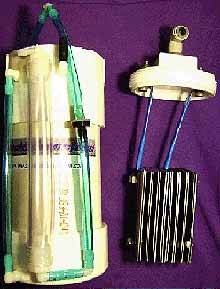
Making hydrogen fuel for cars is actually not that complicated. Hydrolysis separates hydrogen from oxygen and can create what is known as Brown's gas. This gas is not pure hydrogen, but is reactive enough to increase the burning efficiency of fuel already in use. In this manner, a "hydrogen booster" can be made that will work on your existing gasoline-powered car, essentially running your car on hydrogen! The best part of adapting a hydrogen booster to your existing car isn't the increased gas mileage (up to 65-75mpg!), but is the fact that all of the materials are readily available at your local hardware store for under $100.
Cut the PVC pipe to a length of 12 inches and cap one end using the glue on pipe cap. Clean all contact surfaces with pipe cleaner and then apply glue to both the cap and the pipe before securely sliding the pipe cap onto the top of the pipe.
Assemble the metal plates according to the picture, with each plate mounted back to back on the bolt rod, separated by a single nut. Mount the metal straps to the metal plate structure using the extra nuts, and then mount this structure to the lid of the booster using the short bolts.
Drill a hole in the side of the top of the booster and mount the 90 degree elbow here. Push the aquarium tubing onto the elbow and mount the booster on the inside or your engine well. Drill a hole in your air intake tube on your engine and insert the other end of the aquarium tubing into this hole.
Fill the booster 3/4 full with a baking soda and water mixture. Insert the metal plating structure and screw the lid down tight. Connect the positive battery terminal to one screw on the top of the metal bolts mounting the metal plates to the lid and the negative terminal to the other bolt (this allows electricity to flow through the metal plates).
Your booster is now producing hydrogen. Turn the car on and see how it idles. If all is well, you can take it a test drive and start saving!